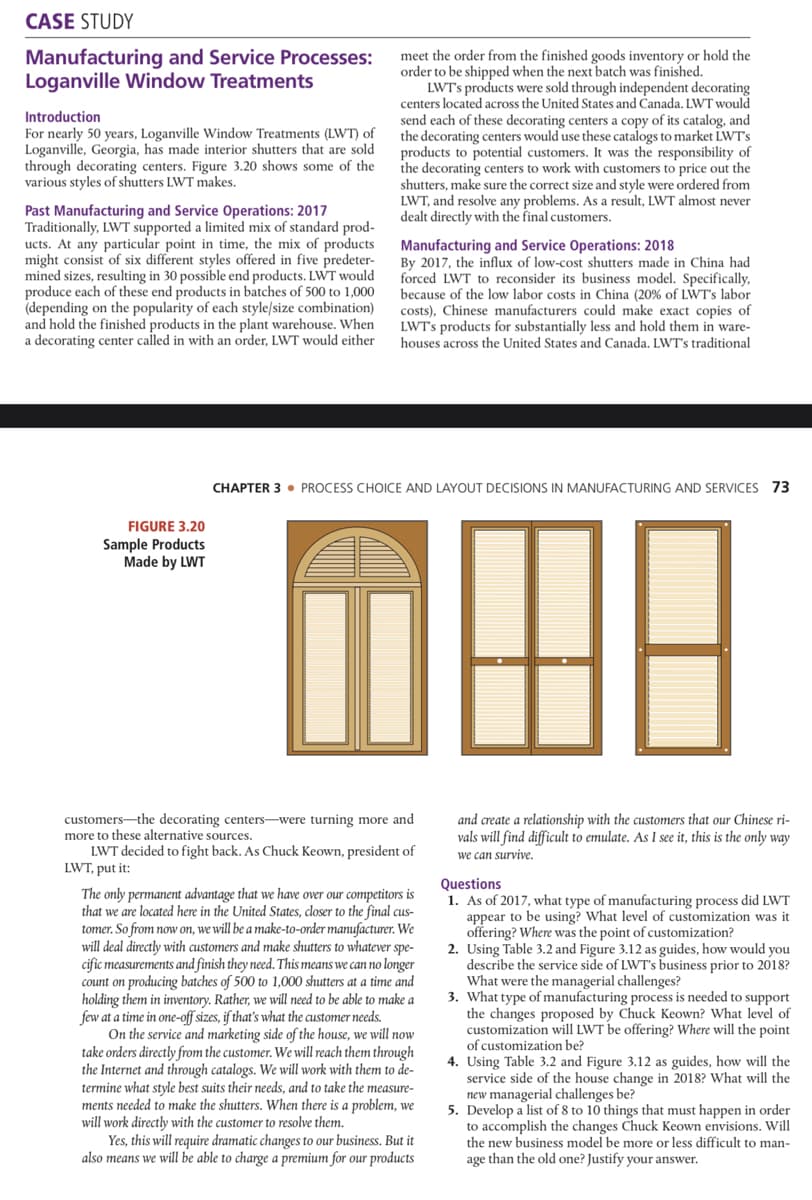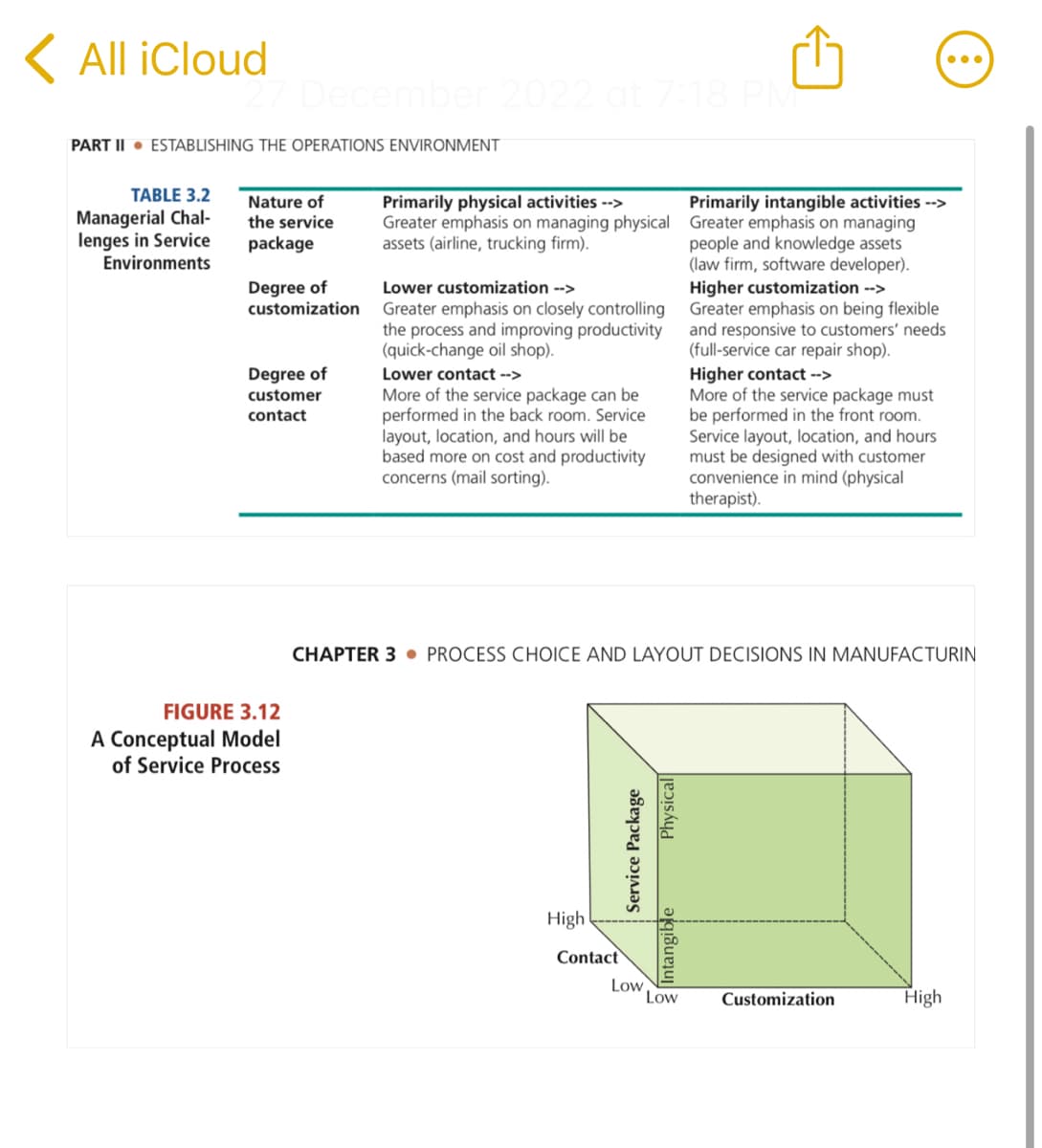what type of manufacturing process did LWT appear to be using? What level of customization was it offering? Where was the point of customization?
what type of manufacturing process did LWT appear to be using? What level of customization was it offering? Where was the point of customization?
Purchasing and Supply Chain Management
6th Edition
ISBN:9781285869681
Author:Robert M. Monczka, Robert B. Handfield, Larry C. Giunipero, James L. Patterson
Publisher:Robert M. Monczka, Robert B. Handfield, Larry C. Giunipero, James L. Patterson
ChapterC: Cases
Section: Chapter Questions
Problem 5.3SD: Scenario 4 Sharon Gillespie, a new buyer at Visionex, Inc., was reviewing quotations for a tooling...
Related questions
Question
Answer Questions 1,2,and 4 :
1. As of 2017, what type of manufacturing process did LWT appear to be using? What level of customization was it offering? Where was the point of customization?
2. UsingTable3.2andFigure3.12asguides,howwouldyou describe the service side of LWT’s business prior to 2018? What were the managerial challenges?
4. Using Table 3.2 and Figure 3.12 as guides, how will the service side of the house change in 2018? What will the new managerial challenges be?

Transcribed Image Text:CASE STUDY
Manufacturing and Service Processes:
Loganville Window Treatments
Introduction
For nearly 50 years, Loganville Window Treatments (LWT) of
Loganville, Georgia, has made interior shutters that are sold
through decorating centers. Figure 3.20 shows some of the
various styles of shutters LWT makes.
Past Manufacturing and Service Operations: 2017
Traditionally, LWT supported a limited mix of standard prod-
ucts. At any particular point in time, the mix of products
might consist of six different styles offered in five predeter-
mined sizes, resulting in 30 possible end products. LWT would
produce each of these end products in batches of 500 to 1,000
(depending on the popularity of each style/size combination)
and hold the finished products in the plant warehouse. When
a decorating center called in with an order, LWT would either
FIGURE 3.20
Sample Products
Made by LWT
meet the order from the finished goods inventory or hold the
order to be shipped when the next batch was finished.
LWT's products were sold through independent decorating
centers located across the United States and Canada. LWT would
send each of these decorating centers a copy of its
f its catalog, and
the decorating centers would use these catalogs to market LWT's
products to potential customers. It was the responsibility of
the decorating centers to work with customers to price out the
shutters, make sure the correct size and style were ordered from
LWT, and resolve any problems. As a result, LWT almost never
dealt directly with the final customers.
Manufacturing and Service Operations: 2018
By 2017, the influx of low-cost shutters made in China had
forced LWT to reconsider its business model. Specifically,
because of the low labor costs in China (20% of LWT's labor
costs), Chinese manufacturers could make exact copies of
LWT's products for substantially less and hold them in ware-
houses across the United States and Canada. LWT's traditional
CHAPTER 3 PROCESS CHOICE AND LAYOUT DECISIONS IN MANUFACTURING AND SERVICES 73
198
customers the decorating centers-were turning more and
more to these alternative sources.
LWT decided to fight back. As Chuck Keown, president of
LWT, put it:
The only permanent advantage that we have over our competitors is
that we are located here in the United States, closer to the final cus-
tomer. So from now on, we will be a make-to-order manufacturer. We
will deal directly with customers and make shutters to whatever spe-
cific measurements and finish they need. This means we can no longer
count on producing batches of 500 to 1,000 shutters at a time and
holding them in inventory. Rather, we will need to be able to make a
few at a time in one-off sizes, if that's what the customer needs.
On the service and marketing side of the house, we will now
take orders directly from the customer. We will reach them through
the Internet and through catalogs. We will work with them to de-
termine what style best suits their needs, and to take the measure-
ments needed to make the shutters. When there is a problem, we
will work directly with the customer to resolve them.
Yes, this will require dramatic changes to our business. But it
also means we will be able to charge a premium for our products
and create a relationship with the customers that our Chinese ri-
vals will find difficult to emulate. As I see it, this is the only way
we can survive.
Questions
1. As of 2017, what type of manufacturing process did LWT
appear to be using? What level of customization was it
offering? Where was the point of customization?
2.
Using
Table 3.2 and Figure 3.12 as guides, how would you
describe the service side of LWT's business prior to 2018?
What were the e managerial challenges?
3.
What type of manufacturing process is needed to support
the changes proposed by Chuck Keown? What level of
customization will LWT be offering? Where will the point
of customization be?
4. Using Table 3.2 and Figure 3.12 as guides, how will the
service side of the house change in 2018? What will the
new managerial challenges be?
5. Develop a list of 8 to 10 things that must happen in order
to accomplish the changes Chuck Keown envisions. Will
the new business model be more or less difficult to man-
age than the old one? Justify your answer.

Transcribed Image Text:< All iCloud
27 December 2022 at 7:18 PM
PART II ESTABLISHING THE OPERATIONS ENVIRONMENT
TABLE 3.2
Managerial Chal-
lenges in Service
Environments
Nature of
the service
package
Degree of
customization
Degree of
customer
contact
FIGURE 3.12
A Conceptual Model
of Service Process
Primarily physical activities -->
Greater emphasis on managing physical
assets (airline, trucking firm).
Lower customization -->
Greater emphasis on closely controlling
the process and improving productivity
(quick-change oil shop).
Lower contact -->
More of the service package can be
performed in the back room. Service
layout, location, and hours will be
based more on cost and productivity
concerns (mail sorting).
High
CHAPTER 3 PROCESS CHOICE AND LAYOUT DECISIONS IN MANUFACTURIN
Contact
Package
Service
Low
Physical
Intangib
Primarily intangible activities -->
Greater emphasis on managing
people and knowledge assets
(law firm, software developer).
Higher customization -->
Greater emphasis on being flexible
and responsive to customers' needs
(full-service car repair shop).
Low
Higher contact -->
More of the service package must
be performed in the front room.
Service layout, location, and hours
must be designed with customer
convenience in mind (physical
therapist).
Customization
High
Expert Solution
This question has been solved!
Explore an expertly crafted, step-by-step solution for a thorough understanding of key concepts.
This is a popular solution!
Trending now
This is a popular solution!
Step by step
Solved in 2 steps

Recommended textbooks for you

Purchasing and Supply Chain Management
Operations Management
ISBN:
9781285869681
Author:
Robert M. Monczka, Robert B. Handfield, Larry C. Giunipero, James L. Patterson
Publisher:
Cengage Learning

Purchasing and Supply Chain Management
Operations Management
ISBN:
9781285869681
Author:
Robert M. Monczka, Robert B. Handfield, Larry C. Giunipero, James L. Patterson
Publisher:
Cengage Learning